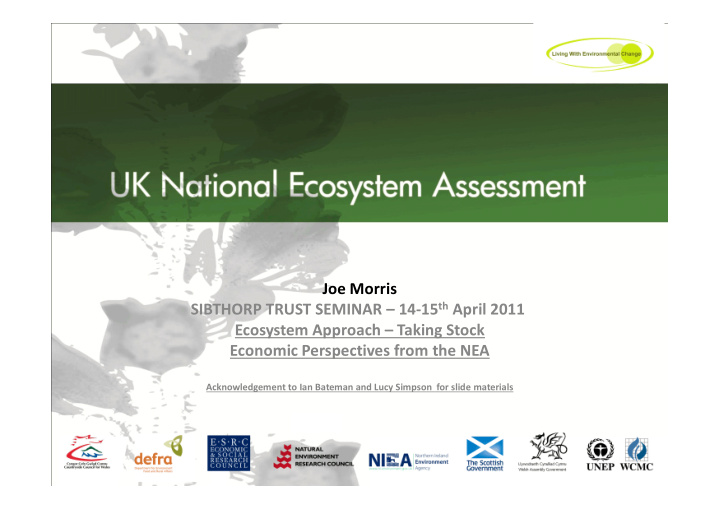



Joe Morris SIBTHORP TRUST SEMINAR – 14-15 th April 2011 Ecosystem Approach – Taking Stock Economic Perspectives from the NEA Acknowledgement to Ian Bateman and Lucy Simpson for slide materials
UK NEA Purpose and Scope the UK’s 1 st attempt at current status and trends a fully national scale assessment of the drivers of change benefits that the natural plausible scenarios environment provides to people valuation
UK NEA Conceptual Framework 3
Economic Analysis of UK Natural Environment and Ecosystem Services Why bother? Free, competitive markets are highly efficient allocators of market priced resources But market and governance systems fail to reflect the full costs and benefits of changes in natural resources and the environment e.g. water quantity and quality, flood defence, recreation and tourism, fisheries, forestry, etc. Likely that decisions do not maximise values Welfare is compromised In the longer term, decisions may not be sustainable.
Cultural Provisioning Approach: From ecosystem services to their value Regulating Supporting Physical and chemical inputs Primary & intermediate Final ecosystem processes services Crops, livestock, fish Weathering Water availability Primary production Trees Decomposition Peat Soil formation Wild species diversity Nutrient cycling Waste breakdown Detoxification Water cycling Purified water Climate regulation Local climate Stabilising vegetation Pollination Natural enemies Evolutionary processes Meaningful places Ecological interactions Wild species diversity
Cultural Provisioning Approach: From ecosystem services to their value Regulating Supporting Other capital Physical and chemical inputs inputs Primary & intermediate Final ecosystem Goods processes services Food Crops, livestock, fish Weathering Drinking water Water availability Primary production Trees Fibre Decomposition Peat Energy Soil formation Wild species diversity Equable climate Nutrient cycling Waste breakdown Pollution control Detoxification Water cycling Flood control Purified water Climate regulation Local climate Disease control Stabilising vegetation Pollination Natural medicine Natural enemies Recreation Evolutionary processes Meaningful places Ecological interactions Good health Wild species diversity
Cultural Provisioning Approach: From ecosystem services to their value Regulating Supporting Other capital Physical and chemical inputs inputs Primary & intermediate Final ecosystem Value of Goods processes goods... services £ Food Crops, livestock, fish Weathering £ Drinking water Water availability Primary production £ Trees Fibre Decomposition £ Peat Energy £ Soil formation Wild species diversity Equable climate £ Nutrient cycling Waste breakdown Pollution control £ Detoxification Water cycling £ Flood control Purified water £ Climate regulation Local climate Disease control £ Stabilising vegetation Pollination Natural medicine £ Natural enemies £ Recreation Evolutionary processes Meaningful places £ Ecological interactions Good health Wild species diversity £
Cultural Provisioning Approach: From ecosystem services to their value Regulating Supporting Other capital Physical and chemical inputs inputs Primary & intermediate Final ecosystem Value of ..of which Goods processes goods... services ES value £ £ Food Crops, livestock, fish Weathering £ £ Drinking water Water availability Primary production £ £ Trees Fibre Decomposition £ £ Peat Energy £ £ Soil formation Wild species diversity Equable climate £ £ Nutrient cycling Waste breakdown Pollution control £ £ Detoxification Water cycling £ £ Flood control Purified water £ £ Climate regulation Local climate Disease control £ £ Stabilising vegetation Pollination Natural medicine £ £ Natural enemies £ £ Recreation Evolutionary processes Meaningful places £ £ Ecological interactions Good health Wild species diversity £ £
Cultural Provisioning Approach: From ecosystem services to their value Regulating Supporting Other capital Physical and chemical inputs ES contribution inputs to well-being Primary & intermediate Final ecosystem Value of Non ..of which Goods processes goods... monetised services ES value ☺ £ £ Food Crops, livestock, fish Weathering £ £ Drinking water Water availability ☺ Primary production £ £ Trees Fibre Decomposition £ £ Peat ☺ Energy £ £ Soil formation Wild species diversity Equable climate £ £ ☺ Nutrient cycling + Waste breakdown Pollution control £ £ Detoxification Water cycling £ £ ☺ Flood control Purified water £ £ Climate regulation Local climate Disease control £ £ ☺ Stabilising vegetation Pollination Natural medicine £ £ Natural enemies ☺ £ £ Recreation Evolutionary processes Meaningful places £ £ Ecological interactions ☺ Good health Wild species diversity £ £
NEA: Ecosystem Service and Environmental Resource Related Goods Food production (agricultural, marine, other) For most goods we estimate: Biodiversity: Use values (pollination, pest control, 1. Total value wildlife, sport ) 2. Per unit value Biodiversity: Non-use values (existence values) Valued via adjusted Raw materials (timber, aggregates, other) market prices Climate regulation (carbon storage, GHG) Water quantity and quality Valued via contribution to output Flood prevention (inland and coastal) Pollution remediation Valued via avoided costs/official values Energy Amenity values (landscape, urban greenspace, Valued via observed behaviour climate amenity, etc) Recreation and tourism Valued via stated Environmental effects upon health preferences
Issues and challenges Understanding biophysical relations Stocks/capital and flow/services Feedbacks and thresholds Handling variation, scale and uncertainty Valuation Values, value and valuation ‘Units of service’ and ‘final goods’ Benefit ‘transfer’ Integrating economic and non-economic valuation Governance and implementation Engaging people: ‘buy in’ http://uknea.unep-wcmc.org Making decisions: making a difference
Recommend
More recommend